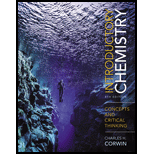
Concept explainers
(a)
Interpretation:
The following metric-English conversions are to be performed.
Concept introduction:
Metric system is a measurement system which has units of meter, liter and gram as the units for measuring length, volume and mass. Adoption of the metric system as a universal system of measurement has been resisted by several countries. In science, measurements are regularly recorded in metric units.
Answer to Problem 22E
The value of
Explanation of Solution
The value of
The conversion factor can be written as
The conversion of
The value of
(b)
Interpretation:
The following metric-English conversions are to be performed.
Concept introduction:
Metric system is a measurement system which has units of meter, liter and gram as the units for measuring length, volume and mass. Adoption of the metric system as an universal system of measurement has been resisted by several countries. In science, measurements are regularly recorded in metric units.
Answer to Problem 22E
The value of
Explanation of Solution
The value of
The conversion factor can be written as
The conversion of
The value of
(c)
Interpretation:
The following metric-English conversions are to be performed.
Concept introduction:
Metric system is a measurement system which has units of meter, liter and gram as the units for measuring length, volume and mass. Adoption of the metric system as an universal system of measurement has been resisted by several countries. In science, measurements are regularly recorded in metric units.
Answer to Problem 22E
The value of
Explanation of Solution
The value of
The conversion factor can be written as
The conversion of
The value of
(d)
Interpretation:
The following metric-English conversions are to be performed.
Concept introduction:
Metric system is a measurement system which has units of meter, liter and gram as the units for measuring length, volume and mass. Adoption of the metric system as an universal system of measurement has been resisted by several countries. In science, measurements are regularly recorded in metric units.
Answer to Problem 22E
The value of
Explanation of Solution
The value of
The conversion factor can be written as
The conversion of
The value of
Want to see more full solutions like this?
Chapter 2 Solutions
Introductory Chemistry: Concepts and Critical Thinking (8th Edition)
- Can I please get help with identifying these?arrow_forward4. Calculate the pH of a 0.10 M acetic acid (CH3COOH) solution if the Ka of acetic acid = 1.8 x 10-5arrow_forwardDraw the Zaitsev product of the dehydration of this alcohol. + I X 5 OH ざ~ TSOH Click and drag to start drawing a structure.arrow_forward
- Please help with identifying these.arrow_forwardFor the reaction: CO2(g) + H2(g) --> CO (g) + H2O (g) Kc= 0.64 at 900 degrees celcius. if initially you start with 1.00 atmoshpere of carbon dioxide and 1 atmoshpere of hydrogen gas, what are the equilibrium partial pressuses of all species.arrow_forwardCan I please get this answered? With the correct number of significant digits.arrow_forward
 ChemistryChemistryISBN:9781305957404Author:Steven S. Zumdahl, Susan A. Zumdahl, Donald J. DeCostePublisher:Cengage Learning
ChemistryChemistryISBN:9781305957404Author:Steven S. Zumdahl, Susan A. Zumdahl, Donald J. DeCostePublisher:Cengage Learning ChemistryChemistryISBN:9781259911156Author:Raymond Chang Dr., Jason Overby ProfessorPublisher:McGraw-Hill Education
ChemistryChemistryISBN:9781259911156Author:Raymond Chang Dr., Jason Overby ProfessorPublisher:McGraw-Hill Education Principles of Instrumental AnalysisChemistryISBN:9781305577213Author:Douglas A. Skoog, F. James Holler, Stanley R. CrouchPublisher:Cengage Learning
Principles of Instrumental AnalysisChemistryISBN:9781305577213Author:Douglas A. Skoog, F. James Holler, Stanley R. CrouchPublisher:Cengage Learning Organic ChemistryChemistryISBN:9780078021558Author:Janice Gorzynski Smith Dr.Publisher:McGraw-Hill Education
Organic ChemistryChemistryISBN:9780078021558Author:Janice Gorzynski Smith Dr.Publisher:McGraw-Hill Education Chemistry: Principles and ReactionsChemistryISBN:9781305079373Author:William L. Masterton, Cecile N. HurleyPublisher:Cengage Learning
Chemistry: Principles and ReactionsChemistryISBN:9781305079373Author:William L. Masterton, Cecile N. HurleyPublisher:Cengage Learning Elementary Principles of Chemical Processes, Bind...ChemistryISBN:9781118431221Author:Richard M. Felder, Ronald W. Rousseau, Lisa G. BullardPublisher:WILEY
Elementary Principles of Chemical Processes, Bind...ChemistryISBN:9781118431221Author:Richard M. Felder, Ronald W. Rousseau, Lisa G. BullardPublisher:WILEY





